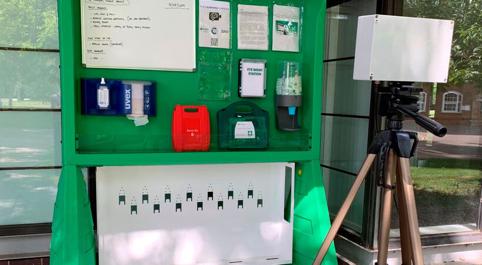
3 minute read
4.1 BAM Nuttall: The Learning Camera
CASE STUDIES
Case study
Advertisement
4.1 BAM Nuttall: The Learning Camera
Sector
• Construction • Rail
Who Was Involved?
• BAM Nuttall - part of the Royal BAM Group of civil engineers and one of Europe’s largest contractors. • Iotics - a technology provider enabling digital twin deployment through their cloud-hosted service.
The Problem
• BAM Nuttall were working on a project involving the restoration of an existing railway bridge and required monitoring assets across the site. One of these was the site’s compressor situated a mile from the site office. The uptime of this asset was critical and located in a hazardous area, which made health checks difficult and monitoring time-consuming. • Live information from across site was not being utilised due to no standardised approach and no method of aggregating the data sources together to utilise relationships between the available information and assets.
Solution
• A standard web camera was used to train a machinelearning model on an attached edge computer, coined The Learning Camera. The device was programmed to recognise a scenario on site to provide an alert automatically so that someone can attend to the situation. For the compressor, this enabled the detection of the compressor display for detecting warnings such as a red warning light. • A further development with Cranfield University enabled a digital twin of a site safety board for capturing changes in the state of the board. For example, it recognised if the first aid kit or fire extinguisher were taken away, and when they were returned allowing multiple notifications to be triggered as needed, such as to alert the site safety officer that there may have been an accident, as well as the purchaser to check on stock levels of the safety essential consumables. • A computer dashboard driven by the Iotic Space platform was the key enabler to present previously disparate information sources collated together in a single environment. This included information Continues...
A construction site’s digital twin(s) would enable a single view all of assets and process across the site facilitating better decision making.
captured on-site as well as other local data sources, such as local weather feeds, to create a composite supervisory digital twin of the construction site. These additional local sources are processed for capturing significant events to drive notifications, such as wind speed being too high for equipment on site to work safely or when assets are idle for longer than a set time so that hired items can be returned to save money on the project.
Outcomes
• Developed and deployed a composite supervisory digital twin across a whole construction site that provided automatic notifications of warnings and issues. • The technology deployed was low cost whilst still suitable for a hazardous construction environment. • Utilised a scalable architecture to feed a dashboard and alert system for a range of assets with multiple sensors and cameras on a construction site. • Iterating during the development was a key factor in the project’s success. During the project the site safety board was augmented with a proximity sensor to alert if the board could be detected. This was important to distinguish if the board had been moved or something had been placed between the camera and the board - both situations which were flagged as dangerous for either not being where required or obstructing a person’s access to the site safety board. CASE STUDIES
Benefits
• The Learning Camera read the compressor display panel; minimising workers’ exposure to hazardous areas and bad weather. • Automated alerts to notify the project team when equipment requires attention; reducing the regularity of health checks. Improved productivity through deploying technology to reduce time spent on non-value added tasks. • Reduced risk though contractors spending less time in hazardous areas and bad weather. • Reduction in menial jobs that took up a significant amount of time thereby impacting productivity.





